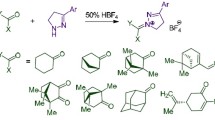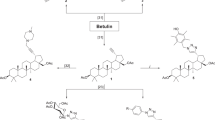Abstract
The importance of virus infections and the early successes with some antiviral drugs have prompted the search for new agents, and it has been focused on compounds that are active against herpesviruses, retroviruses, and rhinoviruses. In this paper, 3H-imidazo[4,5-a]acridones are introduced as new antiviral agents against a panel of DNA and RNA viruses, including herpes simplex virus-1 (KOS), herpes simplex virus-2 (G), vaccinia virus, vesicular stomatitis virus, and herpes simplex virus-1 TK-KOS ACV r. Also, these compounds were cytostatic in the higher micromolar range. 3H-imidazo[4,5-a]acridones were synthesized by Tanasescu reaction of 3H-imidazo[4′,5′:3,4]benzo [c]isoxazoles in concentrated sulfuric acid containing nitrous acid in excellent yields. The advanced compounds were obtained from the reaction of N-alkyl-5-nitrobenzimidazoles with different aryl acetonitriles under basic conditions. Structures of all newly synthesized compounds were confirmed by IR, 1H NMR, and mass spectral data. The results indicated that the title compounds have mild-to-potent activities in comparison with their appropriate reference standards.

Similar content being viewed by others
References
Bakavoli M, Bagherzadeh G, Vaseghifar M, Shiri A, Pordel M, Mashreghi M, Pordeli P, Araghi M (2010) Molecular iodine promoted synthesis of new pyrazolo[3,4-d]pyrimidine derivatives as potential antibacterial agents. Eur J Med Chem 45:647–650
Belmont P, Bosson J, Godet T, Tiano M (2007) Acridine and acridone derivatives, anticancer properties and synthetic methods: Where are we now? Anti-Cancer Agents Med Chem 7:139–169
Clercq ED, Descamps J, Verhelst G, Walker RT, Jones AS, Torrence PF, Shuger D (1980) Comparative efficacy of antiherpes drugs against different strains of herpes simplex virus. J Infect Dis 141:563–574
Clercq ED, Sakuma T, Baba M, Pauwels R, Balzarini J, Rosenberg I, Holy A (1987) Antiviral activity of phosphonylmethoxyalkyl derivatives of purine and pyrimidines. Antiviral Res 8:261–272
Cornil J, Beljonne D, Calbert JP, Bredas JL (2001) Interchain interactions in organic π-conjugated materials: impact on electronic structure, optical response, and charge transport. Adv Mater 13:1053–1067
De Angelis M, Stossi F, Carlson KA, Katzenellenbogen BS, Katzenellenbogen JA (2005) Indazole estrogens: highly selective ligands for the estrogen receptor ß. J Med Chem 48:1132–1144
Dell’Erba C, Novi M, Petrillo G, Tavani C (1992) Behaviour of arylazo tert-butyl sulfides with ketone enolates. competition between srn1 α-arylation and azocoupling reactions. Tetrahedron 48:325–334
Di Giorgio C, Delmas F, Filloux N, Robin M, Seferian L, Azas N, Gasquet M, Timon-David P, Galy JP (2003) In vitro activities of 7-substituted 9-chloro and 9-amino-2-methoxyacridines and their bis- and tetra-acridine complexes against leishmania infantum. Antimicrob Agents Chemother 47:174–180
Gamage SA, Figgit DP, Wojcik SJ, Ralph RK, Ransijn A, Mauel J, Yardley V, Snowdon D, Croft SL, Denny W (1997) Structure-activity relationships for the antileishmanial and antitrypanosomal activities of 1′-substituted 9-anilinoacridines. J Med Chem 40:2634–2642
Girault S, Grellier P, Berecibar A, Maes L, Mouray E, Lemiere P, Debreu MA, Davioud-Charvet E, Sergheraert C (2000) Antimalarial, antitrypanosomal, and antileishmanial activities and cytotoxicity of bis (9-amino-6-chloro-2-methoxyacridines): influence of the linker. J Med Chem 43:2646–2654
Girault S, Delarue S, Grellier P, Berecibar A, Maes L, Quirijnen L, Lemiere P, Debreu-Fontaine MA, Sergheraert C (2001) Antimalarial in vivo activity of bis (9-amino-6-chloro-2-methoxyacridines. J Pharm Pharmacol 53:935–938
Goodell JR, Madhok AA, Hiasab H, Ferguson DM (2006) Synthesis and evaluation of acridine- and acridone-based anti-herpes agents with topoisomerase activity. Bioorg Med Chem 14:5467–5480
Iida T, Satoh H, Maeda K, Yamamoto Y, Ki Asakawa, Sawada N, Wada T, Kadowaki C, Itoh T, Mase T, Weissman SA, Tschaen D, Krska S, Volante RP (2005) Practical synthesis of a neuropeptide y antagonist via stereoselective addition to a ketene. J Org Chem 70:9222–9229
Joshi AA, Viswanathan CL (2006) Recent developments in antimalarial drug discovery. Anti-Infect Agents Med Chem 5:105–122
Kamal A, Srinivas O, Ramulu P, Ramesh G, Kumar PP (2004) Synthesis of C8linked pyrrolo [2,1-c][1,4] benzodiazepine-acridone/acridine hybrids as potential DNA-binding agents. Bioorg Med Chem Lett 14:4107–4111
Kukowska-Kaszuba M, Dzierzbicka K (2007) Synthesis and structure-activity studies of peptide-acridine/acridone conjugates. Curr Med Chem 14:3079–3104
Lang X, Li L, Chen Y, Sun Q, Wu Q, Liu F, Tan Ch, Liu H, Gao Ch, Jiang Y (2013) Novel synthetic acridine derivatives as potent DNA-binding and apoptosis-inducing antitumor agents. Bioorg Med Chem 21:4170–4177
Loudon JD, Tennant G (1964) Substituent interactions in ortho-substituted nitrobenzenes. Quart Rev Chem Soc 18:389–413
Lowden CT, Bastow KF (2003) Cell culture replication of herpes simplex virus and or human cytomegalovirus is inhibited by 3,7-dialkoxylated, 1-hydroxyacridone derivatives. Antiviral Res 59:143–154
Mitra P, Chakraborty PK, Saha P, Ray P, Basu S (2014) Antibacterial efficacy of acridine derivatives conjugated with gold nanoparticles. Int J Pharm 473:636–643
Piotrowska DG, Balzarini J, Gowacka IE (2012) Design, synthesis, antiviral and cytostatic evaluation of novel isoxazolidine nucleotide analogues with a 1,2,3-triazole linker. Eur J Med Chem 47:501–509
Pordel M (2012) Synthesis of new fluorescent compounds from benzimidazole. J Chem Res 36:595–597
Pordel M, Abdollahi A, Razavi B (2013) Synthesis and biological evaluation of novel isoxazolo[4,3-e]indoles as antibacterial agent. Russ J Bioorg Chem 39:211–214
Preston PN (2009) The chemistry of heterocyclic compounds, benzimidazoles and cogeneric tricyclic compounds, Part 1, vol 40. Wiley, London, pp 87–105
Qiao X, Zeitany AE, Wright MW, Essader AS, Levine KE, Kucera GL, Bierbach U (2012) Analysis of the DNA damage produced by a platinum-acridine antitumor agent and its effects in NCI-H460 lung cancer cells. Metallomics 4:645–652
Rahimizadeh M, Pordel M, Bakavoli M, Bakhtiarpoor Z, Orafaie A (2009) Synthesis of imidazo[4,5-a]acridones and imidazo[4,5-a]acridines as potential antibacterial agents. Monatsh Chem 140:633–638
Rahimizadeh M, Pordel M, Bakavoli M, Rezaeian Sh, Sadeghian A (2010) Synthesis and antibacterial activity of some new derivatives of pyrazole. World J Microbiol Biotechnol 26:317–321
Sadeghian H, Sadeghian A, Pordel M, Rahimizadeh M, Jahandari P, Orafaie A, Bakavoli M (2010) Design, synthesis, and structure–activity relationship study of 5-amido-1-(2,4-dinitrophenyl)-1H-4-pyrazolecarbonitrils as DD carboxypeptidase/penicillin-binding protein inhibitors with Gram-positive antibacterial activity. Med Chem Res 19:103–119
Sadeghian A, Pordel M, Safdari H, Fahmidekar MA, Sadeghian H (2012) 11-Chloro-3-methyl-3H-imidazo[4,5-a]acridine (CMIA) as a potent and selective antimicrobial agent against clinical isolates of highly antibiotic-resistant Acinetobacter baumannii. Med Chem Res 21:3897–3901
Sahraei R, Pordel M, Behmadi H, Razavi B (2013) Synthesis of a new class of strongly fluorescent heterocyclic compounds: 3H-imidazo[4,5 a]acridine-11-carbonitriles. J Lumin 136:334–338
Szarfman A, Tonning J, Levine J, Doraiswamy P (2006) Atypical antipsychotics and pituitary tumors: a pharmacovigilance study. Pharmacotherapy 26:748–758
Tanasescu I (1927) Preparation of acridones (and 10-hydroxyacridones) from o-nitrobenzaldehyde and a halobenzene in the presence of concentrated sulfuric acid containing nitrous acid as catalyst. Bull Soc Chim Fr 41:528–532
Werbovetz KA, Spoors PG, Pearson RD, Macdonald TL (1994) Cleavable complex formation in Leishmania chagasi treated with anilinoacridines. Mol Biochem Parasitol 65:1–10
Winter RW, Kelly JX, Smilkstein MJ, Dodean R, Hinrichs D, Riscoe MK (2008) Antimalarial quinolones: synthesis, potency, and mechanistic studies. Exp Parasitol 118:487–497
Author information
Authors and Affiliations
Corresponding author
Ethics declarations
Conflict of interest
The authors declare that they have no conflict of interest.
Research involving human participants and/or animals
This article does not contain any studies with human participants or animals performed by any of the authors.
Informed consent
For this type of study, formal consent is not required.
Rights and permissions
About this article
Cite this article
Daghigh, L.R., Pordel, M., Davoodnia, A. et al. Synthesis, antiviral, and cytotoxic investigation of imidazo[4,5-a]acridones. Med Chem Res 24, 3912–3919 (2015). https://doi.org/10.1007/s00044-015-1438-1
Received:
Accepted:
Published:
Issue Date:
DOI: https://doi.org/10.1007/s00044-015-1438-1




